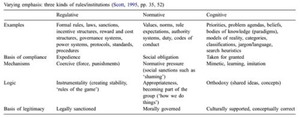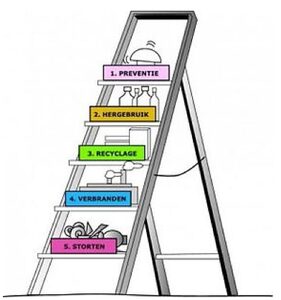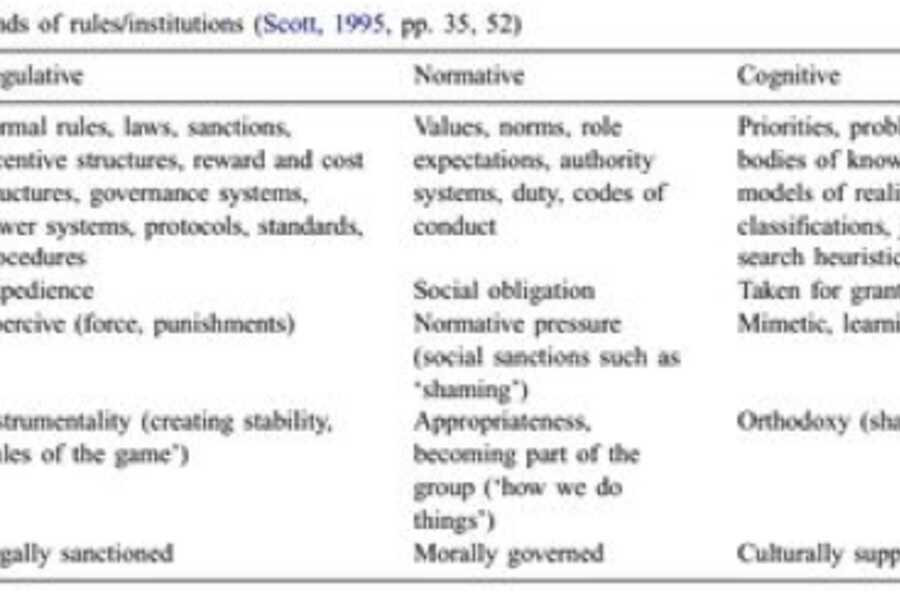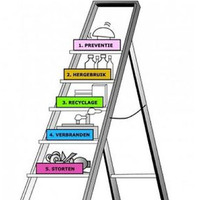Within the system there are several important rules and regulations. Geels (2002) reports on three types of rules: regulative, normative and cognitive rules which are depicted in figure 3.6 (Geels, 2002). On the regulatory level we have analyzed the policies that are written by the Texel government, since these kind of regulations are implied on a local level, sometimes following national or European directives. The documents were found on the government website by scanning the local policies on waste directives and by looking for regulations on beaches and sewage, which we consider also important.

Figure 3.6 Three types of rules and examples. Adopted from: Geels (2002)
Exploring the normative rules is a bigger challenge. Normative rules confer values, norms, role expectations, duties, rights, responsibilities. It is about the norms in society and how society expects people to treat their waste. It will probably be tough to find out the actual norms on this because Geels notes that these tend to be unwritten. Finally, cognitive rules constitute the nature of reality and the frames through which meaning or sense is made. Paradigms on how people interact with waste and if they perceive it as valuable would be a more tangible definition of this concept in my opinion. An example could be the earlier mentioned “jutterscultuur” of Texel which used to be an important part of the cultural heritage of Texel and should be considered as a more informal set of rules. The informal norms on waste treatment in Texel would be an interesting further investigation and maybe an idea for our interview topic.
3.3.1 Regulative Rules
In the societal needs part we distinguished six points on which current policy focuses. We implicitly assumed that the current policy was enough to cover the societal needs, but this could be further explored by an investigation of the norms on waste treatment as proposed earlier. If we analyze the current policy on these six points, we come to the following conclusions. The policies mentioned below are from the document Grondstoffenplan from the Texel government, but these are based upon European and national directives. Therefore, alterations in these regulations should also fit into the overruling directives. The overall principle in the European directives is that the polluter pays. In the national directive, the guideline is provided by the so called “Ladder van Lansink” which is visualized in figure 3.7 (Gemeente Texel, 2013).

Figure 3.7 Ladder van Lansink. It reads: Prevention, re-use, re-cycle, Incineration and landfill. This visualizes that the concepts that are mentioned first are the most desirable, based on their limited impact on the environment. Source: Recybem.nl
Combining these principles means that waste should be treated as much as a resource as possible and those who do not comply with these principles are the ones who pay the price of the steps that have to be taken to get rid of the waste. An example of this is the removal fee, a national law which has to be paid if one buys a new apparatus. We continue below with the different regulations on the several focus points.
- Waste disposal – Glass, compostable waste, paper, plastics and other wastes are collected separately or policy to collect it separately has been passed. The percentage of separation in Texel is about 50%, compared to 61% in comparable districts. The government aims to get 65% separation by 2020.
- Waste Re-usage - For our cradle to cradle approach, it is specifically important to consider what is done with the waste after it has been collected. Texel aims to re-use 70% of its waste in 2020, which is higher than the general Dutch aim of 65 % by 2020. The purpose is to have as much of the waste processed on the island itself, otherwise it should be transported as efficiently as possible to the main land. It has been researched whether an anaerobic digester on the island for the purpose of gas and energy extraction from compostable waste would be cost-efficient but this was not the case in 2002. Recently, new plans have been presented and these and other initiatives are evaluated on their cost-efficiency and technical feasibility, which seems to be the general principle for these initiatives on the island.
- Waste Amount – As explained earlier, the one who pollutes pays. General waste taxes are asked to every citizen, where the amount is differentiated for single households, family homes and recreational homes. There are around 2000 single households, 4000 families and 1200 recreational homes on Texel that pay waste taxes. Companies have to pay an amount that depends on the type of waste and the amount of collections per year (Decentrale Regelgeving Overheid, 2013). Something noticeable is that it is cheaper to have “general waste” collected than “compostable waste”. This is probably not stimulating the separation of waste by companies.
- Waste collection systems camouflage – Plans for this are developed in the form of underground collecting systems which have to be finished by 2015.
- Waste in nature and streets – The new waste collection systems have to help the prevention of waste in nature. In general, there isn’t a lot of waste in the nature and on the streets of Texel, according to research that was performed by the government.
- Clean beaches – The hospitality industry on the beach is responsible for cleaning up the beaches up to 25 meters surrounding their restaurant or beach bar. Beyond this, it is the duty of the government that cleans it up according to the demand, but at least twice a year the entire beach is cleared from waste. On top of this, people can signal the government when a bin has to be emptied which will be done as soon as possible.
In section 3.3.3.1 we further introduce the VANG program, a program of the Dutch Government that could help with the transition of the Dutch economy towards a more sustainable economy.
3.3.2 Normative and Cognitive Rules.
As noted earlier, information on the normative and cognitive rules will be hard to find. Below we discuss some small insights and we discuss how we can alter these sets of rules.
Since we want to re-design the waste streams on Texel towards a cradle-to-cradle design, a way to look into these normative and cognitive rules would be to see how concepts from circular business models are perceived in Texel. A start has been given with the national MyBeach initiative, where it is basically not done to leave your waste on the beach. These norms are spread via the hospitality industry, volunteers and schools (Gemeente Texel, 2013). According to the MyBeach website, at least 6 companies are participating on the Texel beach (MyBeach, 2014).
The cognitive rules set also reports on priorities and beliefs. We have been taught in the lectures that people from Texel are resistant to change and the cognitive set of rules is probably a conservative one on a lot of areas.
3.3.3 Major trends, developments and initiatives that are relevant to the transition of the system?
Besides the normative and cognitive rules on Texel, a lot of initiatives in both The Netherlands and Europe will influence the waste system of Texel. This section is used to introduce these initiatives.
3.3.3.1 Domestic initiatives
As mentioned before, a good campaign that is already active on the island and along the entire coast is “My beach”. Thanks to it, the beaches are cleaned out of the waste plastics coming from touristic activities before they can get into the sea and pollute it, and they are used to decorate big and fancy sculptures. The people involved are volunteers and the owners of the pavilions located on the beaches. The idea has a double effect: it cleans the beaches, while it contributes for social engagement and creation of a funny activity, where also kids can be involved. In summer, when the tourism rate is higher, the collection of waste is organized weekly (MyBeach, 2014).
On a national level, several initiatives are organized which include the policy program van afvalstof naar grondstof (from waste to resource, VANG-program). The VANG program has as goal to improve the sustainable sourcing, resource efficiency, eco-design and substitution of non-sustainable materials and increasing recycling and repair rates of objects. link
This program is interesting, since it will stimulate initiatives that are ahead in their time. Therefore, the blue economy initiatives of chapter 7 could potentially benefit from subsidiary aid.link
In the end of september, the program until then was evaluated. This gave some key recommendations that are also interesting for Texel. The first recommendation was that it misses an exploration of how the circular economy could look like. If Texel starts implementing the initiatives we mention in chapter 7, it could become a example for the rest of The Netherlands. The fourth recommendation is that the current policy is focusing too much on the end of the chain (recycling) instead of the chances at the beginning of the chain (waste prevention). Innovations should also become more socially accepted which should be a focus of the VANG program. The sixth comment says that local best practices should be better shared and upscaled. It should be considered that current investments are already done, for instance in waste incineration centrals. If the waste stream is reduced, these centrals become less financially viable. Therefore, the current infrastructure should also be addressed. link
We will try to incorporate the findings of the VANG program evaluation in our intervention for Texel. On top of this, we will find out in the mushroom case study if this is feasible for VANG subsidy.link
3.3.3.2. Foreign initiatives
A current initiative that is very good for waste reduction is the packaging-free market, which hopefully will become more and more common. An example is the one that will open in the city of Berlin. It is a market where the food is not wrapped in packages, and the consumers bring their own containers, that will be weighted at the entrance. It is a way to reduce the waste coming from the packaging but not only. It results also in a reduction of the food and products bought, because there will not be as much choice as in normal markets, helping also in decreasing nowadays’ consuming mentality (Borromeo, 2014).
A growing number of technologies are being lately developed for waste treatment combined with energy production. One of them uses anaerobic digestion. Anaerobic digestion is a series of processes, where microorganisms are able to break down biodegradable material in absence of oxygen. When used as part of the waste management system, the anaerobic digestion can reduce the emission of landfill gases while producing renewable energy. The process’s product is a biogas containing methane, carbon dioxide and other gases. This biogas can be used as fuel or be improved to become bio-methane, while the remaining materials of the digestion process are highly nutrient-rich and can be used as fertilizer. With the re-use of waste and the production of biofuel this technology is being more and more applied lately, especially by UK, Germany and Denmark (American Biogas Council, sd) .
Another process that can be used for a sustainable treatment of biodegradable and plastic waste is the Gasification process. It converts organic or fossil fuel into carbon monoxide, hydrogen and carbon dioxide, by using high temperatures, without combustion and controlled amount of oxygen and steam. The gas resulting from the process is called syngas, which is considered a renewable energy source, when obtained by biomass. Using syngas instead of burning the initial waste or fuel is more efficient because it can be combusted at higher temperatures or also in fuel cells (Wikipedia.org, sd).
A similar process that converts organic materials into syngas using plasma, is called Plasma gasification. It ionizes gas and catalyzes organic matter into syngas. Many are the advantages: it provides a clean way of disposing hazardous waste, preventing them to reach landfill; it does not result in toxic waste emissions, while it provides clean alloyed slag that can be used as construction material; it turns organic waste into combustible syngas for electric power and thermal energy (Dodge, 2014; Wikipedia.org, sd).
However, it is not only these kind of technologies that are increasingly developed. Also the way of thinking, in circular business models, is trending according to this report of Accenture from 2014. → link
The report of Accenture notes on five new business models for circular economies;
- Circular supplies: Provides fully renewable, recyclable or biodegradable resource inputs that underpin circular production and consumption systems.
- Resources recovery: Enables a company to eliminate material leakage and maximize the economic value of product return flows.
- Product life extension: Allows companies to extend the lifecycle of products and assets. Value that would otherwise be lost through wasted materials are instead maintained or even improved by repairing, upgrading, remanufacturing or remarketing products.
- Sharing platforms: Promotes a platform for collaboration among product users, either individuals or organizations.
- Product as a service: Provides an alternative to the traditional model of “buy and own.” Products are used by one or many customers through a lease or pay-for-use arrangement. This business model turns incentives for product durability and upgradability upside down, shifting them from volume to performance.
Although Texel will probably not be the starting point of such business models, it could very well be that a successful business model elsewhere spreads to Texel at one point, helping the transformation towards a more sustainable Texel. The fifth business model - product as a service - is actually the blue economy view. If one company owns for instance 30 % of the washing machines on Texel and another company owns another 25%, these companies could compete with each other on product durability and sustainability. This would be an interesting shift to witness.



